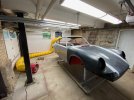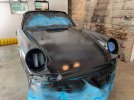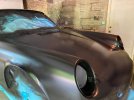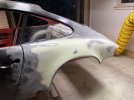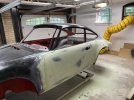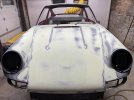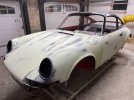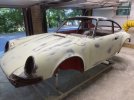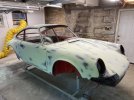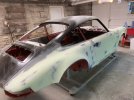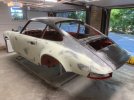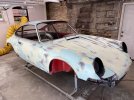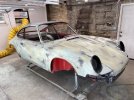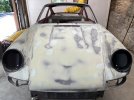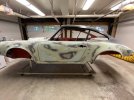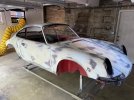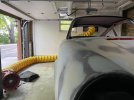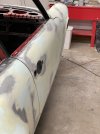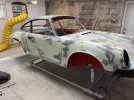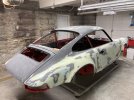getto822000
Promoted Users
Hello there,
I've been lurking in these forums for a few months and today finally painted my car in SPI black epoxy. For the past 7 months I've worked on restoring a 1988 Porsche 911 as a 1973RS tribute car. It's been a lot of fun and hard work. I've never done bodywork before, but have done many engine and race car builds in the past.
After cutting off and replacing the entire roof, front clip and rear bumper, I finally finished the metalwork on the car. This morning I put on two coats of black SPI epoxy using a FUJI Q5 turbine sprayer with T75G gun and 1.5 tip. It worked pretty well the over spray was manageable in my small booth setup. The first coat was WAY TOO HEAVY, as I poorly adjusted the fluid needle. I then dialed it in and the final coat laid smoothly. I do have some runs from the first coat. But I'm planning to do my bodywork now and sand off the runs anyway so no sweat.
The major thing I am wanting to know, is the best process for using epoxy as a build primer? How long should it cure between coats? How many coats does it take? Any advice from you all on this topic? I'm going to take my time with this and finish the body filler and build primer over the summer. I can wait and let it cure, dry, shrink or whatever is needed to flat it out. My booth setup pulls air from my house and works very well for that. I can feed the room with 72 degree, 40% humidity air, then after it cures a bit I can open the doors and let the sun shine on it and have the summer heat help bake the epoxy.
In the end, I'm going to try to paint it with Glasurit 22 single stage with my turbine sprayer. I have a gallon of it in Aubergine purple which was an original color from 1973. I know this kind of painting is hard to do for a rookie, but I'm willing to go slow and learn, just like I have with all the metalwork.
Any and all advice is greatly welcome!
Adam
I've been lurking in these forums for a few months and today finally painted my car in SPI black epoxy. For the past 7 months I've worked on restoring a 1988 Porsche 911 as a 1973RS tribute car. It's been a lot of fun and hard work. I've never done bodywork before, but have done many engine and race car builds in the past.
After cutting off and replacing the entire roof, front clip and rear bumper, I finally finished the metalwork on the car. This morning I put on two coats of black SPI epoxy using a FUJI Q5 turbine sprayer with T75G gun and 1.5 tip. It worked pretty well the over spray was manageable in my small booth setup. The first coat was WAY TOO HEAVY, as I poorly adjusted the fluid needle. I then dialed it in and the final coat laid smoothly. I do have some runs from the first coat. But I'm planning to do my bodywork now and sand off the runs anyway so no sweat.
The major thing I am wanting to know, is the best process for using epoxy as a build primer? How long should it cure between coats? How many coats does it take? Any advice from you all on this topic? I'm going to take my time with this and finish the body filler and build primer over the summer. I can wait and let it cure, dry, shrink or whatever is needed to flat it out. My booth setup pulls air from my house and works very well for that. I can feed the room with 72 degree, 40% humidity air, then after it cures a bit I can open the doors and let the sun shine on it and have the summer heat help bake the epoxy.
In the end, I'm going to try to paint it with Glasurit 22 single stage with my turbine sprayer. I have a gallon of it in Aubergine purple which was an original color from 1973. I know this kind of painting is hard to do for a rookie, but I'm willing to go slow and learn, just like I have with all the metalwork.
Any and all advice is greatly welcome!
Adam

